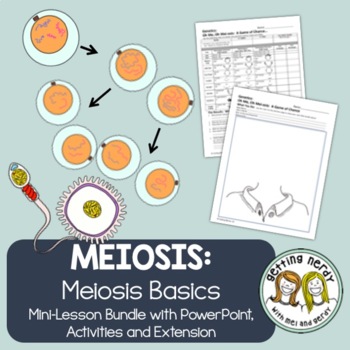Meiosis Cell Division - PowerPoint, Notes, Class Survey and Project
- Zip
Description
Ensure your students understand the difference between meiosis and mitosis with this 1-day mini-bundle that covers meiosis cell division and the creation of haploid and diploid cells. In this lesson, students will take brief notes about egg and sperm production, calculate the number of chromosomes in somatic cells and sex cells, and complete a class survey of shared traits. Students summarize this meiosis lesson by creating a baby as they flip coins to determine the traits of their offspring.
This is a great introductory lesson into meiosis and could easily lead into a more in-depth discussion about chiasma and crossing over, sex-linked traits, and acquired versus inherited traits.
WHAT'S INCLUDED in this 1 DAY LESSON:
• EDITABLE PPT Presentation
→ Lesson introduction slide with objective and warm-up
→ Notes aligning with PDF
• NON-EDITABLE PDF handouts
→ Student note-taking page
→ Class survey activity
→ Make a baby project
→ Teacher guide and answer key
STUDENTS WILL:
• Use the PPT to learn about and take notes on meiosis
• Poll the class to collect data on shared traits among classmates
• Flip coins to determine traits of offspring
• Draw the offspring showing inherited traits
• Answer extension questions
TEACHERS LOVE THIS, HERE'S WHY:
❤️Beth C. says, "Great resource. Very clear information. Good clarifying activity for those struggling with the concept."
❤️ Katelynn A. says, "Great resources with great visuals! My students enjoyed the PowerPoint as well as the notes that went with it. Fun activities as well!"
❤️Laura C. says, "Your products make my life so much easier!!!"
THIS PRODUCT IS ALSO FOUND IN OUR:
• Life Science Curriculum Bundle
CHECK OUT OUR OTHER GENETICS RESOURCES:
• Fortune Teller Life Science Vocabulary Bundle
• WinterThemed Punnett Square Practice Problems and Activity
• Fall Themed Punnett Square Practice Problems and Activity
SEE HOW THIS LESSON ALIGNS WITH NGSS, TEKS or GSE
Because we have created many of our own graphics or have purchased licenses to other graphics with permission, we cannot offer our resources in editable format unless otherwise stated.
TERMS OF USE (TOU):All rights reserved by GETTING NERDY®️.
• This product is to be used by the original purchaser only
• Intended for classroom and personal use only
• Copying for more than one teacher, classroom, department, school, or school system is prohibited.
• This product may not be distributed or displayed digitally for public view
Failure to comply is a copyright infringement and a violation of the Digital Millennium Copyright Act (DMCA). Clipart and elements found in this PDF are copyrighted and cannot be extracted and used outside of this file without permission or license.
Meiosis Cell Division - PowerPoint, Notes, Class Survey and Project © 2012 to present GETTING NERDY®️ All Rights Reserved





